International Journal of Modern Education and Computer Science @ijmecs
Статьи журнала - International Journal of Modern Education and Computer Science
Все статьи: 1123
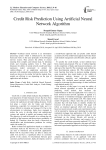
Credit risk prediction using artificial neural network algorithm
Статья научная
Artificial neural network is an information processing system which is influenced by the human brain and works on the same principles of the biological nervous system. They possess the ability to extract meaning from complex and intricate data, by detecting trends and extracting patterns from it. This paper illustrates the ability of neural network model and linear regression model constructed to predict the creditworthiness of an application accurately and precisely with minimal false predictions and errors. The results are shown to be similar for both the models, thus, models are efficient to use depending on the type of application and attributes.
Бесплатно
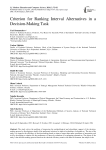
Criterion for Ranking Interval Alternatives in a Decision-Making Task
Статья научная
The study solves the problem of improving the methodological and algorithmic support of the decision-making process by developing a model of the preference criterion for interval evaluations of alternatives. The aim of the study is to improve the efficiency of decision-making based on interval expert data under conditions of uncertainty and risk by developing a criterion for the preferences of interval evaluations of overlapping alternatives. The object of the study is the decision-making process based on the classical efficiency matrix with interval elements, the subject is the model of decision maker's (DMP) preference criteria for interval evaluations of alternatives. The relevance of the task is stipulated by the urgency of the problem of adapting classical decision-making methods and models to practical problems of gray analysis, in particular, with interval uncertainty of primary expert data. A multifactorial model of the normalized preference criterion for interval evaluations of alternatives is proposed. Due to the additional consideration of the degree of preference of the DMP for the width of interval estimates, it allows ranking interval estimates of alternatives that overlap and are considered classically incomparable. A single analytical form of the normalized criterion model for ranking interval, weighted interval and point estimates makes it possible to increase the degree of automation of processing interval expert estimates in the decision-making process. Recommendations for the practical application of the proposed model are formulated. The developed model and corresponding algorithms can be used in automated expert decision support systems.
Бесплатно
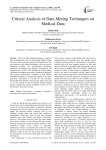
Critical Analysis of Data Mining Techniques on Medical Data
Статья научная
The use of Data mining techniques on medical data is dramatically soar for determining helpful things which are used in decision making and identification. The most extensive data mining techniques which are used in healthcare domain are, classification, clustering, regression, association rule mining, classification and regression tree (CART). The suitable use of data mining algorithm can enhance the quality of prediction, diagnosis and disease classification. Valuation of data mining techniques demand for medical data mining is the major goal here, particularly to examine the local frequent disease like heart ailments, breast cancer, lung cancer and so on. We examine for discovering the locally frequent patterns through data mining technique in terms of cost performance speed and accuracy.
Бесплатно
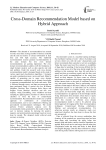
Cross-domain recommendation model based on hybrid approach
Статья научная
The demand of recommendation has aroused severely since there are huge number of choices available and the end user desires to extract information in least time and with high accuracy. The traditional recommendation systems generate recommendations in the same domain but now cross domain recommendations are gaining importance. The cross domain recommendations address well the limitations of single domain analysis such as data sparsity and cold start problem. Under this research work cross domain recommendation model is designed based on the study of various supervised classification algorithms. 3 domains are under consideration music, movie and book. Model is capable of generating one to many cross domain recommendations exploiting movie domain knowledge to generate recommendations for books and music. Data is collected through survey and data pre-processing has been performed. Study is carried out over K-Nearest Neighbor, Decision Tree, Gaussian Naïve Bayes and Support Vector Machine classifiers and also over majority voting Ensembling, cross validation and data sampling by applying these classifiers to choose the best classifier to form the base of content-based recommendation. Recommendation model uses a hybrid approach of combination of content-based recommendation, user to user collaborative filtering and personalized recommendation techniques. The model perform Twitter sentiment analysis over the recommended entities generated by the model to help the user in decision making by knowing the positive, negative and neutral polarity percentage based on tweets done by people. The designed model achieved good accuracy on testing.
Бесплатно

Cuckoo Search Algorithm using Lèvy Flight: A Review
Статья научная
Cuckoo Search (CS) is a new metaheuristic algorithm. It is being used for solving optimization problem. It was developed in 2009 by Xin- She Yang and Suash Deb. Uniqueness of this algorithm is the obligatory brood parasitism behavior of some cuckoo species along with the Levy Flight behavior of some birds and fruit flies. Cuckoo Hashing to Modified CS have also been discussed in this paper. CS is also validated using some test functions. After that CS performance is compared with those of GAs and PSO. It has been shown that CS is superior with respect to GAs and PSO. At last, the effect of the experimental results are discussed and proposed for future research.
Бесплатно
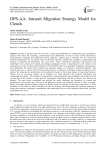
DPS-AA: Intranet Migration Strategy Model for Clouds
Статья научная
Intranets & Intranet-wares have become a central junction/platform for implementing the organization’s specific work culture like computing, communication and collaboration. In order to ensure smooth and effective communication, computing and collaboration among employees, intranets play an important role. For vertical and horizontal management, we use intranet-wares for directing, reporting, collaborating, socializing, communicating and meeting or discussing the professional and social issues. Today, cloud-based computing, communication, and collaboration have created new frontiers and emerging paradigms towards re-engineering of work cultures in the organizations. In order to enhance the performance with extended features, next-generation computing, communication, and collaboration the intranet needs redesign and migration strategy over alternative technology platforms. This research paper tries to answer the research questions that how an alternative technology strategy or pathway can be explored for enhancing the performance and extending the features of the exiting designs of educational Intranets. Further; how an on-premise intranet can be migrated over cloud platforms with enhanced performance and extended/add-on features. After analysis of collected facts, understanding the issues, challenges and limitations of the existing state of art intranets, a strong need for performance enhancement and add on features was observed for Intranets. The study deeply investigated and analyzed the issues, challenges and limitations i.e. features and performances of the current state of the art of the intranets in general and on-premise Intranet of AMU in specific. Finally, an Intranet Migration Strategy Model over Hybrid Cloud was designed and developed using SaaS (i.e. AMU CloudNet). In this study, the Interact Intranet was used for designing and demonstrating the functional prototype of intranet show that how computing, communication and collaboration services can be enhanced with anytime, anywhere and boundary-less access.
Бесплатно
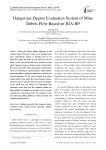
Dangerous Degree Evaluation System of Mine Debris Flow Based on IGA-BP
Статья научная
Taking the western Qinling Mountain, in the southern Shaanxi Province of china, as an example, based upon comprehensive analysis of geological data for 20 debris flow gullies, the author has put forward a series of indices system and has developed one evaluation system called “dangerous degree evaluation system of mine debris flow based on IGA-BP”. This system adopts Visual Basic 6.0 and Access technology to manage database, adopts immune genetic algorithm to optimize the hidden layer structure and network parameters of BP neural network and adopts sample model of mine debris flow whose dangerous degree has been known to realize the BP neural network evaluation of the debris flow risk which to be determined. The calculating results show that this evaluation method has high reliability and simplicity of operation, and it can make comprehensive evaluation precisely. The evaluation results have important guiding significance in the prevention and reduction mine debris flow.
Бесплатно
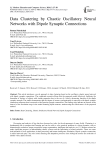
Data Clustering by Chaotic Oscillatory Neural Networks with Dipole Synaptic Connections
Статья научная
This article introduces a novel approach to data clustering based on the oscillatory chaotic neural network with dipole synaptic connections. The conducted research affirms that the proposed model effectively facilitates the formation of clusters of objects with similar properties due to the use of a slowly decreasing function of the dipole synaptic strength. The studies demonstrate that the degree of neuron synchronization in networks with dipole synaptic connections surpasses that in networks with Gaussian synaptic connections. The findings also indicate an increase in the interval of the resolution range in the model featuring dipole neurons, underscoring the effectiveness of the proposed method.
Бесплатно
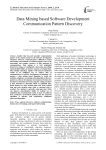
Data Mining based Software Development Communication Pattern Discovery
Статья научная
Smaller time loss and smoother communication pattern is the urgent pursuit in the software development enterprise. However, communication is difficult to control and manage and demands on technical support, due to the uncertainty and complex structure of data appeared in communication. Data mining is a well established framework aiming at intelligently discovering knowledge and principles hidden in massive amounts of original data. Data mining technology together with shared repositories results in an intelligent way to analyze data of communication in software development environment. We propose a data mining based algorithm to tackle the problem, adopting a co-training styled algorithm to discover pattern in software development environment. Decision tree is trained as based learners and a majority voting procedure is then launched to determine labels of unlabeled data. Based learners are then trained again with newly labeled data and such iteration stops when a consistent state is reached. Our method is naturally semi-supervised which can improve generalization ability by making use of unlabeled data. Experimental results on data set gathered from productive environment indicate that the proposed algorithm is effective and outperforms traditional supervised algorithms.
Бесплатно

Data Mining with Associated Methods to Predict Consumer Purchasing Patterns
Статья научная
Technology is developed and utilized as an honest computer in order that it can provide useful information. With the aim of developing and meeting business objectives, the utilization of sales transaction data in minimarket GP is processed into information or knowledge as a recommendation to ascertain the possible value of purchased simultaneously. This processing uses data mining. Database buildup in computerized systems is justified by getting added value from this data set. Data mining can predicts trends and therefore the nature of business behavior which is extremely useful to support important deciding. The algorithm wont to form the association rules during this study is CT-Pro. CT-Pro algorithm may be a development of FP-Growth. The difference is within the second step where FP-Growth creates the FP-Tree arrangement while CT-Pro makes the Compressed FP-Tree (CFP-Tree) arrangement. The CT-Pro algorithm process by analyzing employing a tree system where the things most frequently purchased become root and other items will follow the basis. The CFP-Tree process will provide levels for every transaction and facilitate mining results. CT-Pro algorithm implementation with CFP-Tree arrangement applied to data mining systems is in a position to research sales data for 3 months, namely January 2020 – March 2020 with a complete data record of 1.303 and 320 sales transactions at minimarket GP become information or knowledge. The results of this study are the relationship between the tendency of products that are bought together based on categories in a kind of percentage to be used as a recommendation in structuring the position of items that are mutually frequent in certain categories.
Бесплатно
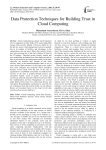
Data Protection Techniques for Building Trust in Cloud Computing
Статья научная
Cloud computing has played much important role in comparison to other fields of IT, in providing Data storage, Data security, Quality of Services (QoS) etc. In the last few years, it had emerged and evolved so quickly due to its number of facilities and advantages to the organizations and end users. Many data security factors have also increased due to this fast evolution of cloud in the IT industry. Therefore several security models and trust establishing techniques have been deployed and are been in execution for providing more security to the data, especially the sensitive data. Despite of that much security, many of the models/techniques lacks in one or more security threat measures. In this paper a new model have been designed and proposed which introduces Security Aware Cloud. First the trust of the user or organization is established successfully on cloud than the security to the data is granted through privacy and encryption module. Level of quality of service and security are achieved under the Contract Trust layer while the Authentication and Key Management are covered under Internal Trust layer. For critical data privacy and encryption, Homomorphism mechanism is used. By the use of proposed trust and security model, we can enhance Return on Investment factor in the cloud for the data security and service provided by it.
Бесплатно
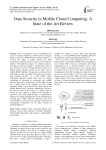
Data Security in Mobile Cloud Computing: A State of the Art Review
Статья научная
Due to tremendous use of smartphones the concern of cloud computing in mobile devices emerges, which is known as Mobile Cloud Computing (MCC). It involves the usage of mobile devices and cloud computing to perform resource intensive tasks using the internet with minimum impact on cellular resources. Nowadays, people are relying on mobile devices due to their small size and user friendly interface but due to its limited storage capacity, people can no more rely on internal RAM. Therefore, this promotes a drastic need for technology to make it possible for anyone to access their data anywhere anytime. As a result, Mobile Cloud Computing facilitates mobile users with its enticing technology by providing its on-demand and scalable services. But privacy and security are the main concern for a mobile user in the modern era. Thus, issues regarding security can be divided into cloud security and mobile network user’s security, respectively. However, the primary focus of this study is to analyze how to secure the user's data in a mobile cloud. Leading to objectives, the current study presents a comprehensive analysis of existing techniques that can be considered for securing data in MCC efficiently. Moreover, this work will contribute a state-of-the-art roadmap to research and development communities for the right selection of proposed approach.
Бесплатно
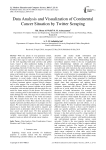
Data analysis and visualization of continental cancer situation by twitter scraping
Статья научная
With the advent of user-generated content, usability, and interoperability of web platforms, people are today more eager to express and share their opinions on the web regarding both daily activities and global issues. Cancer is often undetected, leading to serious issues which continue to affect a person's life and his surroundings. Recently Twitter has been very popular to be used to predict and monitor real-world outcomes as well as health-related concerns. Nowadays people are using social media in any situation. Even cancer patients, their friends, and family are increasingly sharing their experience in social media, which has increased the ability of patients to find others similar to their conditions to discuss treatment options, suggest lifestyle changes, and to offer support. Our work targets to link patients with a particular illness (cancer) together and to provide researchers with enriched patient data that might be very useful for future analysis of this disease. We wanted to create a meeting point for the healthcare sector and social media through our work. Our target was to collect Twitter data from different continents of the world and analyze them. We scraped tweets from over the last two years from all around the world. Then clean the data using a regular expression and then process it to prepare our own dataset. We used sentiment analysis and natural language processing to classify them into positive, negative and neutral tweets to determine which of the tweet means to have cancer and which don't. We then analyzed the prepared dataset and visualized and compared them with veritable cancer-related information to ascertain if people's tweets are allied with actual cancer situation.
Бесплатно
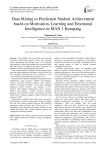
Статья научная
The problems that exist in the school decline in student achievement ahead of class III, especially before approaching the national exam. If the learning achievement of third-grade students can be known earlier then the school can perform the actions necessary for students to achieve good learning achievement. This research uses two methods of data mining, Neural Network Model Multilayer Perceptron, and Decision Tree. For comparison, this study also uses t-statistic test, t-test and to compare precision/recall using Roc Curve. Neural Network Model Multilayer Perceptron Positive performance vector accuracy: 88.64% and Negative: 14.07%, precision (positive guidance class) positive 88.00% and negative 16.88%, recall (class: Ordinary guidance) positive 84.50%, and negative 21.73%. Decision Tree Positive performance vector accuracy: 84.82% and Negative: 15.24%, precision (positive guidance class) positive 86.55% and negative 18.52%, recall (class: ordinary guidance) positive 84.00% and negative 23.85%. Experiments conducted in this study aims to prove that data mining can predict student achievement by finding the best data mining method between the multilayer perceptron neural network and Decision tree to be implemented into integrated information system between student motivation data, student learning interest, and intelligence emotional students.
Бесплатно
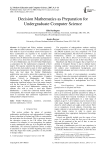
Decision Mathematics as Preparation for Undergraduate Computer Science
Статья научная
In England and Wales, students commonly take what are called Advanced ‘A’ level examinations in their final two years of secondary school. Good passes in these examinations are required to be accepted onto university degree courses. 123 Computer Science students from 24 different UK universities participated in an online survey about their perceptions and experiences of A-level Mathematics and A-level Further Mathematics as preparation for the mathematical component of their degree. The majority reported that decision mathematics units that they had studied as part of either qualification had been good preparation for their degree. Additionally, those who had taken the Further Mathematics qualification were positive about their experience and its utility as preparation for undergraduate Computer Science. A-levels in Mathematics and Further Mathematics in England and Wales are currently undergoing significant reform. One of the major changes will see the removal of Decision Mathematics as an optional topic in A-level Mathematics, meaning that students who wish to study it must take Further Mathematics – a much less commonly studied subject. Consequently, this research might encourage admissions tutors to reconsider their admissions requirements for undergraduate Computer Science.
Бесплатно
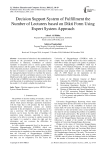
Статья научная
Assessment of education is the standardization imposed by the government to be followed by all universities in Indonesia. Fulfillment of national standards of education aims to ensure quality higher education practices and the quality of its graduates, One of the education practices assessment are assessment of the ratio of lecturers to students. This study aims to help the managerial prepare lecturers to facilitate the process of education and the accreditation process to be faced. Model used with expert system for its inferencing engine with the help of ARIMA forecasting algorithm to predict until the period of accreditation, Forecasting results show the model (1,1,0) which is eligible for prediction.
Бесплатно
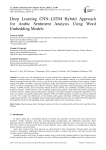
Deep Learning CNN–LSTM Hybrid Approach for Arabic Sentiment Analysis Using Word Embedding Models
Статья научная
In recent years, the widespread use of social networks has empowered online users to freely share their opinions on diverse aspects of life. Sentiment Analysis (SA) has consequently emerged as a pivotal domain within Natural Language Processing (NLP), serving a crucial role in discerning sentiment orientations and extracting valuable insights from public viewpoints. Analyzing sentiment in Arabic poses distinctive challenges due to its varied dialects, as well as its intricate morphological and syntactic structures. Deep Learning (DL) models, particularly Long Short-Term Memory (LSTM) networks and Convolutional Neural Networks (CNNs), have exhibited remarkable proficiency in Sentiment Analysis. LSTM networks excel in capturing sequential data patterns, while CNNs offer inherent advantages in feature selection, yielding superior performance compared to conventional machine learning (ML) algorithms. In our study, we propose an ensemble approach that integrates CNN and LSTM techniques to classify and forecast sentiment in tweets. We evaluate the effectiveness of this hybrid model against individual LSTM and CNN methodologies employing the FastText word embedding model. Experimental findings illustrate that our LSTM-CNN hybrid approach, leveraging the FastText word embedding model, significantly improves text classification accuracy.
Бесплатно
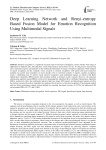
Статья научная
Emotion recognition is a significant research topic for interactive intelligence system with the wide range of applications in different tasks, like education, social media analysis, and customer service. It is the process of perceiving user's emotional response automatically to the multimedia information by means of implicit explanation. With initiation of speech recognition and the computer vision, research on emotion recognition with speech and facial expression modality has gained more popularity in recent decades. Due to non-linear polarity of signals, emotion recognition results a challenging task. To achieve facial emotion recognition using multimodal signals, an effective Bat Rider Optimization Algorithm (BROA)-based deep learning method is proposed in this research. However, the proposed optimization algorithm named BROA is derived by integrating Bat Algorithm (BA) with Rider Optimization Algorithm (ROA), respectively. Here, the multimodal signals include face image, EEG signals, and physiological signals such that the features extracted from these modalities are employed for the process of emotion recognition. The proposed method achieves better performance against exiting methods by acquiring maximum accuracy of 0.8794, and minimum FAR and minimum FRR of 0.1757 and 0.1806.
Бесплатно
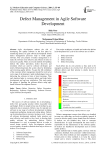
Defect Management in Agile Software Development
Статья научная
Agile development reduces the risk of developing low quality software in the first place by minimizing defects. In agile software development formal defect management processes help to build quality software. The core purpose of defect management is to make the software more effective and efficient in order to increase its quality. There are several methods for handling defects like defect prevention, defect discovery and resolution which are used by software developers and testers. Refactoring keeps the system clean by identifying and removing quality defects. To gain the full confidence of the customer defect management should be involved at every stage of development. Agile methodologies focus on delivering the software in form of short iterations. Thus each iteration helps to overcome defects and leads better development and end user satisfaction. This study paints the picture of handling the software defects using agile based Software Development Process.
Бесплатно
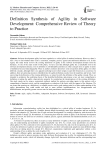
Definition Synthesis of Agility in Software Development: Comprehensive Review of Theory to Practice
Статья научная
Software development agility has been regarded as a critical pillar of modern businesses. However, there is still a way to find whether there exists a consistent, complete, precise, agreed and uniformed definition of it. In this regard, this study firstly reviews the existing definitions of agility in the software development domain from the literature. As one of the main results of this phase, we have seen that although agility has a remarkable root in the software development domain, even its definition is still debatable and there are other concepts close to agility in terms of definition but used interchangeably. There is another confusion about how some researchers define agility over other different concepts, although there is no apparent unifying factor in their origins except their historical co-occurrence. In addition, there are particular practices embedded into the agility definitions mostly from the manifesto and Scrum. After uncovering the deficiencies of the existing definitions, we aimed to ratify the definition of the agility concept. Then, we intended to synthesize the underlying facets of the identified definitions and propose a new yet more comprehensive definition revealing the agility characteristics properly by considering the interpretations of the existing definitions. Our study stands out by using a customized synthesis method for analysis, providing inputs to this analysis with a comprehensive literature review, and the comprehensive evaluation of the facets with the support of the literature. We are aware that agreeing on a definition is a valuable exercise and a good starting point for a better understanding of the agility phenomenon that could enable and lead to more realistic implementations, less disappointment and disillusionment, and possibly greater success rates for both practitioners and researchers.
Бесплатно

